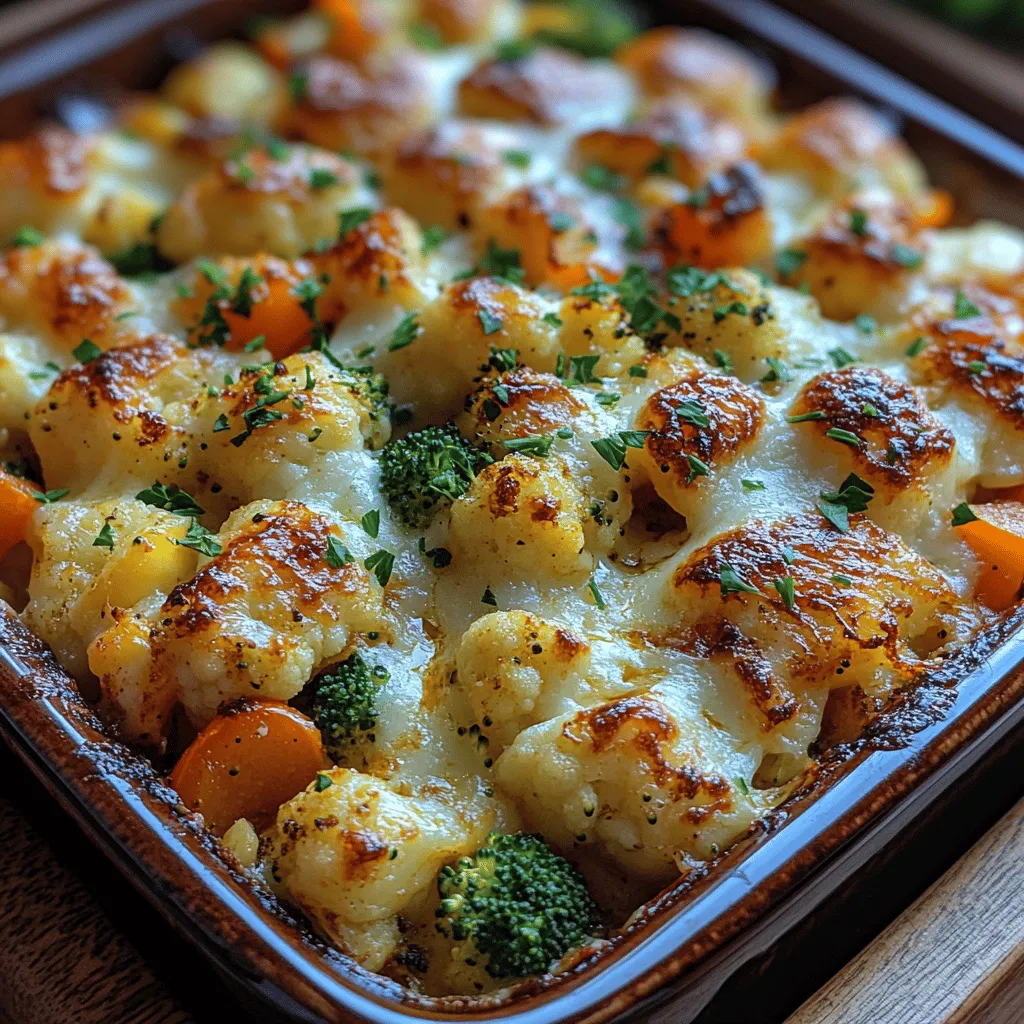Creamy Roasted Veggie Casserole: A Comfort Food Classic
Comfort food holds a special place in the hearts of many, often evoking memories of family gatherings and cozy nights spent around the dinner table. These dishes, rich in flavor and nostalgia, provide warmth and satisfaction, making them a staple in home cooking. Among the many delightful options, the Creamy Roasted Veggie Casserole stands out as an exceptional choice, combining nutrition with indulgence. This dish is not only delicious but also versatile enough to cater to various dietary preferences, making it an ideal centerpiece for family dinners or meal prep.
The Creamy Roasted Veggie Casserole is a vibrant medley of vegetables enveloped in a rich, creamy sauce. It can easily be adapted for vegetarians or enhanced with added protein, such as chicken or beans, to create a heartier meal. With its colorful presentation, this casserole is sure to please both the palate and the eye, making it a perfect addition to any table setting.
Understanding the Ingredients
To create a truly memorable Creamy Roasted Veggie Casserole, it is essential to understand the star ingredients that contribute to its flavor and nutritional value.
Primary Vegetables:
The foundation of this casserole lies in a selection of fresh vegetables, each bringing its own unique characteristics to the dish. Broccoli and cauliflower, both cruciferous vegetables, are packed with vitamins C and K, fiber, and various antioxidants. They not only add a pleasing crunch but also provide numerous health benefits, including support for heart health and improved digestion.
Bell peppers and zucchini contribute to the casserole’s vibrant color palette while delivering a delightful flavor profile. Bell peppers are rich in vitamin A and antioxidants, while zucchini is a low-calorie vegetable that provides hydration and dietary fiber. Together, they create a harmony of textures and tastes that elevate the dish.
Corn adds a touch of sweetness that balances the savory elements, while red onions and garlic infuse the casserole with aromatic qualities. The combination of these ingredients enhances the overall flavor, creating a dish that is satisfying and wholesome.
Herbs and Spices:
No casserole would be complete without the addition of herbs and spices. These ingredients play a crucial role in enhancing the dish’s flavor, transforming simple roasted vegetables into a gourmet experience. Fresh herbs such as thyme, rosemary, or parsley can be used to add depth and aroma, while spices like paprika or black pepper provide a subtle kick.
Cream and Cheese Components:
The creamy sauce is what truly sets this casserole apart. The combination of cream and cheese creates a luxurious texture that envelops the vegetables, making each bite rich and satisfying. Whether you opt for a traditional cream-based sauce or a lighter alternative, the goal is to achieve a smooth, velvety consistency that complements the roasted veggies perfectly.
For those looking to add more substance, consider incorporating pasta into the dish. This optional ingredient can transform the casserole into a complete meal, providing additional carbohydrates that make it even more filling and comforting.
Preparation Steps for Success
With a clear understanding of the ingredients, it’s time to focus on the preparation steps that will ensure your Creamy Roasted Veggie Casserole turns out perfectly.
Preheating the Oven:
One of the first steps in preparing this delectable casserole is to preheat your oven. This step is crucial, as the right temperature is key to achieving perfectly roasted vegetables. Aim for a temperature of 425°F (220°C) to ensure that your veggies caramelize beautifully, enhancing their natural sweetness and flavor.
Roasting the Vegetables:
Once the oven is preheated, it’s time to prepare your vegetables for roasting. Start by washing and chopping them into uniform pieces. This ensures even cooking, allowing all the vegetables to roast at the same rate. Toss the chopped veggies with a drizzle of olive oil, salt, and pepper, ensuring they are well-coated. Spreading them out evenly on a baking sheet is vital for allowing air circulation, which promotes even cooking and prevents steaming.
Roasting is a transformative process that caramelizes the natural sugars in the vegetables, resulting in a deep, rich flavor. During roasting, it’s important to toss the vegetables halfway through to ensure that all sides are evenly browned and cooked. Depending on the type of vegetables used, roasting can take anywhere from 20 to 30 minutes, so keep an eye on them to prevent overcooking.
Crafting the Cream Sauce:
While the vegetables are roasting, you can prepare the creamy sauce that will bring the casserole together. Start by melting butter in a saucepan over medium heat. Once melted, add in minced garlic and sauté until fragrant, being careful not to let it burn. Next, whisk in flour to create a roux, cooking it for a minute to eliminate the raw flour taste.
Gradually add your choice of cream, stirring continuously to achieve a smooth texture. As the sauce thickens, season it with salt, pepper, and any additional herbs or spices you prefer. For those desiring a cheesier flavor, fold in grated cheese of your choice, allowing it to melt and integrate into the sauce.
By following these preparation steps, you set the stage for a delightful Creamy Roasted Veggie Casserole that will impress family and friends alike. As we continue with the recipe, you’ll learn how to assemble the casserole and create a dish that exemplifies comfort and nourishment in every bite.

Combining Ingredients
Once your roasted vegetables have cooled slightly, it’s time to bring together all the elements that will make your Creamy Roasted Veggie Casserole a standout dish. Begin by preparing your cream sauce, which will serve as the luscious base that binds everything together.
1. Mixing the Roasted Veggies with the Cream Sauce: In a large mixing bowl, combine the roasted vegetables with the cream sauce. Use a spatula to gently fold the sauce into the veggies, ensuring that each piece is coated evenly. This step is crucial; proper mixing allows the flavors to meld beautifully, ensuring that every bite is rich and creamy.
2. Importance of Even Distribution: Achieving an even distribution of the cream sauce among the vegetables is essential for consistent flavor throughout the casserole. You want each serving to deliver the same delightful taste, so take your time in this step. If some vegetables are left uncoated, they may taste bland compared to the others, detracting from the overall experience.
Assembling the Casserole
Now that your ingredients are combined, it’s time to assemble your casserole.
1. Transferring the Mixture to the Casserole Dish: Carefully pour the combined roasted veggies and cream sauce mixture into a greased casserole dish. Use a spatula to spread the mixture evenly across the dish, ensuring that it fills the corners and edges.
2. Importance of Greasing the Dish: Greasing the casserole dish is a crucial step that often gets overlooked. A well-greased dish will help prevent the casserole from sticking, making it easier to serve once baked. You can use cooking spray, olive oil, or butter for this task.
3. Layering Cheese for the Best Melt and Browning: For the ultimate finishing touch, sprinkle a generous layer of cheese over the top of the casserole. For optimal melting and browning, consider using a blend of cheeses, such as mozzarella for stretchiness and cheddar for flavor. Layering the cheese evenly allows it to melt uniformly, creating that perfect golden-brown crust that is so inviting.
Baking to Perfection
With your casserole assembled, it’s time to pop it in the oven.
1. Explanation of the Baking Process: Preheat your oven to 350°F (175°C). Place the casserole dish in the oven and bake for approximately 30-35 minutes. During this time, the cheese will melt, bubble, and develop a beautiful golden color, while the flavors of the vegetables and cream sauce will meld together.
2. What to Look For When It’s Done: The casserole is ready when the cheese on top is bubbly and golden brown, and the edges are slightly crispy. You can also check for doneness by inserting a fork into the center; it should come out easily without resistance, indicating that the vegetables are perfectly tender.
3. The Science of Cheese Melting and Browning: Understanding the science behind cheese melting can enhance your cooking experience. When cheese melts, the proteins break down, and the fat begins to separate. As it cooks, the Maillard reaction occurs, giving the cheese its appealing golden color and rich flavor. A well-baked casserole will offer a delightful contrast between the creamy interior and the crispy topping.
Garnishing and Serving Suggestions
Once your casserole is out of the oven, let it cool for a few minutes before garnishing and serving.
1. Importance of Garnishing: A simple garnish can elevate your dish both visually and flavor-wise. Consider sprinkling fresh herbs, such as chopped parsley or basil, over the top of the casserole before serving. This adds a pop of color and a fresh flavor that complements the richness of the dish.
2. Suggestions for Side Dishes or Accompaniments: This Creamy Roasted Veggie Casserole pairs wonderfully with a variety of side dishes. A crisp green salad dressed with a light vinaigrette can provide a refreshing contrast to the hearty casserole. Alternatively, serve it alongside some crusty bread for a comforting meal. For those looking for a protein boost, grilled chicken or baked fish can be excellent additions.
3. Serving Size Recommendations: This casserole serves approximately 6-8 people, making it perfect for family dinners or gatherings. To store leftovers, allow the casserole to cool completely, then cover it tightly with plastic wrap or aluminum foil and refrigerate. It can be reheated in the oven or microwave.
Nutritional Information
Understanding the nutritional value of your meal is essential for maintaining a balanced diet.
1. Breakdown of Calories and Macronutrients: Each serving of Creamy Roasted Veggie Casserole contains around 350 calories, depending on the specific ingredients used. It typically consists of about 15 grams of protein, 20 grams of carbohydrates, and 25 grams of fat.
2. Health Benefits: This casserole is packed with nutrients from the variety of vegetables, offering vitamins, minerals, and dietary fiber. The use of whole grains in the pasta can add additional fiber and nutrients, making this dish a wholesome option. Furthermore, by using low-fat cream or a dairy-free alternative, you can reduce the calorie content while still enjoying the creamy texture.
3. Dietary Considerations: This casserole can be easily adapted to fit various dietary lifestyles. For a vegetarian option, simply ensure that the cream sauce is made without any animal products. If you’re looking for gluten-free options, consider using gluten-free pasta or quinoa as the base.
Conclusion
The Creamy Roasted Veggie Casserole is not just a meal; it’s a comforting dish that brings warmth and joy to the table. With its combination of roasted vegetables, creamy sauce, and melted cheese, this casserole is a crowd-pleaser that is sure to satisfy even the pickiest eaters.
Cooking and sharing meals with loved ones is a rewarding experience that fosters connection and creates cherished memories. So, gather your ingredients, don your apron, and try this delightful recipe for a delicious and satisfying meal option that celebrates the flavors of wholesome cooking. Enjoy every bite of this creamy, comforting casserole that embodies the essence of home-cooked goodness.

